 |
Scenic Line Members' Reports 31 December 2011 |
|---|
DCC - LocoNet
After reconnecting some standard gauge RJ12 plug-ins, LocoNet seems to be functioning correctly. We did notice on
Wednesday night that every 40 seconds or so, a throttle speed would drop to zero. This prblem went away with a battery
installed in the throttle. No problems were detected Saturday while operating a throttle wireless (with battery
installed). Batteries are to be removed from throttles and returned to the battery shelf (DCC cabinet) at end of
sessions.
Gray's Siding
Jacob declared this scenery as "complete." The fascia was cut down at the corner. Plexiglass will be installed to wrap
around to protect scenery but allow a better view.



Mear's Junction
Jacob also declared this scenery at Mears' as "complete."


We cut down the fascia adjacent to the trestle and Hal displayed mock-ups of the depot and hotel.






Shawano
The fascia was cut down at the saddle point where the drainage pipe will go.

Helix
Barry began replacing soldered joiners on the helix track, by slipping the flextrack rails into a joiner, and soldering
that joiner to a PC tie, but not soldering the rails. Thermal expansion during the summer and contraction during the
winter just continued kinking the helix track annually. It was noticed that most flextrack connections were soldered to
the joiner, prohibiting sufficient expansion and contraction.
News & Notes
DCC - LocoNet
LocoNet Update: After much disatifaction with LocoNet performance, further diagnostics were undertaken. According to the
Digitrax manual, the NET indicator light should be always RED when in RUN mode, and flicker when receiving commands. This
was confirmed. It also states that almost all LocoNet problems can be traced to wiring problems. Currently, Throttles
are not acquiring locomotives consisitently or at all when plugged in a RJ12 jack. Unplugging LocoNet from Port 'A' on
the DCS100 Command Station, and plugging in a throttle directly in Port 'A', showed perfect operation of all throttles. The
following diagnostic steps were taken:
Gray's Siding
Four new photos of Jacob's awesome landscaping (in progress) have been added to the Modeling pictures on the layout page.
Mear's Junction
A photo displaying the transition from Grays to Mears is with the photograph displayed next to the backdrop, near the
bottom of the Mears' Jct layout page. It is actually the view from the Mears' main trestle looking north to the roadbed
rounding to the right to Poncha Pass, which is the first photo displayed at the top of the layout page. Two additional
photos of Jacob's recent work of underbrush and tree planting are also posted to the Layout page Modeling pictures.
Helix
Walthers 85' Heavyweight cars were tested. It was noticed that it appeared some trucks' wheels would lift off the rails.
It also appeared that the trucks may be restricted somewhat from staying 'flat' on the rails because of the screw contacts
to the metal contact plates on the underneath side of the floor. Fine-tuning experimentation of cars to continue.
Gray's Siding
Jacob added to the ground cover, scrub, and trees.
Parlin
Gerry removed a tight spot on the aisle side siding by cutting the flex track spikes and regluing the rails with CA.
DCC - Command Station
More troubleshooting to do on the LocoNet cabling.
Mear's Junction
Jacob has begun adding ground cover along the Poncha creek bed.
Alex has been telling me that I need to work on the Layout webpages. So now when I add photos, I will update the Layout webpage as well. Click on the "Blue Lettering Link" in the name "Mear's Junction" for a shortcut to the layout page.
Gray's Siding
GaryM finally completed the backdrop at Gray's, allowing Jacob to continue with the foreground scenery.
New photos are availble through the link.
Portland
It was discovered that the east switch on the passing siding was out of alignment with the flextrack rails. Hal crimped
down the joiner to match up the rail height and Barry was able to further adjust to prevent derailments from occurring.
News & Notes
DCC - Command Station
A lot of troubleshooting on the LocoNet cabling. We did make a mistake using an extension rather than a jumper to connect
remote sections. Following that correction, Barry did find a broken wire in one cable and troubleshooting may be now
complete.
Mear's Junction
Jacob and Hal installed creek bed using the plaster cloth technique. Jacob has since began applying the ground paint and
dirt.


Salida
The east floor of the Narrow Gauge roundhouse was installed a ways back. Each track will be powered with a switch.
![]()
Gray's Siding
Gary has been working on the backdrop from Mears to the cut. At the TCA show on the 27th, Gary started making more and
more aspen.
Shawanno
Gerry has been working on the backdrop from Shavanno to the Tank 7.
Helix
Another portion of the helix was found with some minimum curvature violations, as well as some wandering track. Track
nails were extracted, the non-compliant track section was caulked in place with 30" radius sweeps and weighted with
iron spikes. Helix needs track cleaning and testing for next Ops session.
News & Notes
DCC - Command Station
Still experiencing trouble with LocoNet - not being able to activate the system. LocoNet was unplugged from the Command
Station, a throttle plugged into Port "A" to turn track power "Off", "On", and "Off", system shut down and restarted,
LocoNet replugged in. Still need to isolate this problem.
Staging Deck
Staging entrance ladder work on adjustments to the micro-switches that were not activating when switched.
Helix
Track on the bottom loop right off the staging deck was found to have an incursion to the minimum 30" radius requirement.
Track nails were pulled, adhesive caulk put down, two 30" radius Ribbon Rail spans were placed in the rails to smooth
curve, and weighted down with some real spikes to dry.
Mear's Junction
Scenery work continued along Poncha Creek through Mears.
Gray's Siding
Rail on the siding at the east end was CA'd to the ties where it had separated from the ties.
Marshall Pass
Most of the remaining unpainted ties from the west end of Gray's to the east switch at the top of the pass were painted a
gray enamel.
Notables
DCC - Command Station
Saturday had trouble with LocoNet - not being able to activate the system. LocoNet was corrupted from leaving a
rechargeable battery in one of the throttles. The trickle charge applied to the throttles is insufficient to the
rechargeable batteries during SLEEP Mode, and somehow provides a garbage feedback into LocoNet. After unplugging all
throttles and LocoNet from the Command Station, turning everythnig off and on a couple times, finally cleared the system
and then everything finally worked fine. We experienced this problem before when we left the batteries in the throttles
plugged in. Therefore, please remove all rechargeable batteries from throttles at end of the day. When unplugging the
throttle from the layout, the battery voltage will show on the screen. Batteries under 7.8 volts should be placed back on
one of the charger units in the DCC cabinet.
Gray's Siding
The ties from Gray's to Mears were completed by drybrushing a dark brown enamel, followed by another drybrush coat of
black. A Floquil paint pen of Rust color was lovingly applied to the top of the spikes.
Shavanno
More cardboard strips were added from Shavanno to Marshall Pass, clearly framing the landscape. The slope of the cut was
reduced to a less sharp angle and the tank area moved slightly "west" to allow for more gradual slope in the saddle.
DCC - Command Station
DCC user friendly instruction sheets were reviewed. PM4 instructions in process of being added. We had a lengthy review
of DCC equipment this morning.
Salida
We had several locomotives running under load in Salida including some narrow gauge, and managed to draw >3 amps,
prompting the trip circuit to activate. This will require the block to be set at 4.5 amps, which will be updated in the
PM4 instructions.
Crested Butte
The auto-reverse leg of the wye had been found to cause an intermittent short in Crested Butte when the locomotive would
cross the second set of gaps along that leg of the wye. This was eliminated by setting the PM4 block for Crested Butte
to SLOW fault detection time (approximately 1/2 second) as opposed to FAST. Previously, all other locos in the block
would briefly stall while a loco crossed through the leg during the auto-reverse, now there is no noticeable change
in running of a locomotive while one runs through the gaps of the auto-reversed wye leg.
Helix
Grant's Pennyslvania Rivarossi cars successfully made it up and down the helix, although there was a coupler issue with
the Huron sleeper.
Operations
Ops consisted of test running locomotives and equipment, cleaning wheels, lubrication, and getting equipment in order.
Gary's new Walthers D&RGW PS Streamline coaches & heavyweight baggage almost made it through the helix - one trailing wheel
jumped the rail - some more searching and corrective action for the helix, but huge improvements. A few engines got some
long neglected maintenance and started performing well, but we still need more engines for Ops, especially switchers.
DCC - Command Station
Great News! Barry & Gary finally were able to diagnose the DCS100 Command Station Indicator's 8 blinks per 4 sec and finally
make corrections. We also cleared and erased all consists, routes, and loco roster (stack) from the system. We expect trains
to run smoothly with less issues. We also discovered how to properly set the PM4 parameters for Autoreverse and normal
sections, current settings per block, and fast/slow fault detection per block. Saturday, Oct 22 we would like to test out
our amperage draw by running combinations of narrow and standard gauge locos in Salida, so bring your equipment. Gary is
in the process of writing up user friendly instruction sheets for power up/down sequence, PM4 and Command Station checkout
for diagnostics to be performed prior to Ops sessions. The goal of the instruction sheets are they are easily usable by
everyone, so we will test them out to see.
Salida
Gary and Barry were able to operate the 65' Turntable correctly after finding a rail feeder improperly connected to the
turntable leads (by yours truly) and resetting the autoreverse correctly on the PM4 block.
All leads to the tracks between the turntables have been connected and work properly. The east floor of the narrow gauge roundhouse is now secured to the benchtop. Track feeders will be connected to a rotary switch so power can be selectively applied to one stall at a time.
Staging Deck
A throw against a micro-switch was adjusted to fully close the switch on the reverse loop end of Track #3 to properly
change frog polarity, thus, the staging ladder should now work properly at that end.
Mear's Junction
Last month a lot of lanscape was put in between Mear's and Poncha Junction, with mostly around a couple briges to finish.
We need more hot glue sticks and latex gloves!
Gray's Siding
The rails have been repainted from Mear's to the middle of the siding. This is where removing some ballast had removed some
paint. The ties that had also received some paint removal have been repainted a couple shades of gray and now await
dry-brushing brown & black.
Shavanno
The ground is being roughed in with some cardstock strips. Rails have been painted from Marshall Pass to Parlin (using the
Floquil Rail Brown pen). Some preliminary backdrop art by Gerry, but now on hold til we get the landscape figured out
better.
Monarch
Gerry built a platform extension to project along the face of Poncha Junction, allowing for reach to the empties track at
the CF&I Mine. Gerry's working on a larger section to replace the box at top (with wheels). Hal has been closing up seams
on the foam scenery, with some help from Andrew. Hal also added some rock wall cribbing on the steep slope between the
fascia and the scenery.





Mear's Junction
Hal and Andrew began sculpting the foam foundation for the Mears hotel by securing foam sheet with caulk.

Operations
Gary continues to gear up for operations, with Barry and Grant helping out by testing trains and cleaning track. At
Marshall Pass, the snow sheds were re-installed. The dispatch panels show some of the train magnets attached to the
boards. We haven't run in a long time, so all locomotives and rolling stock are being test run.

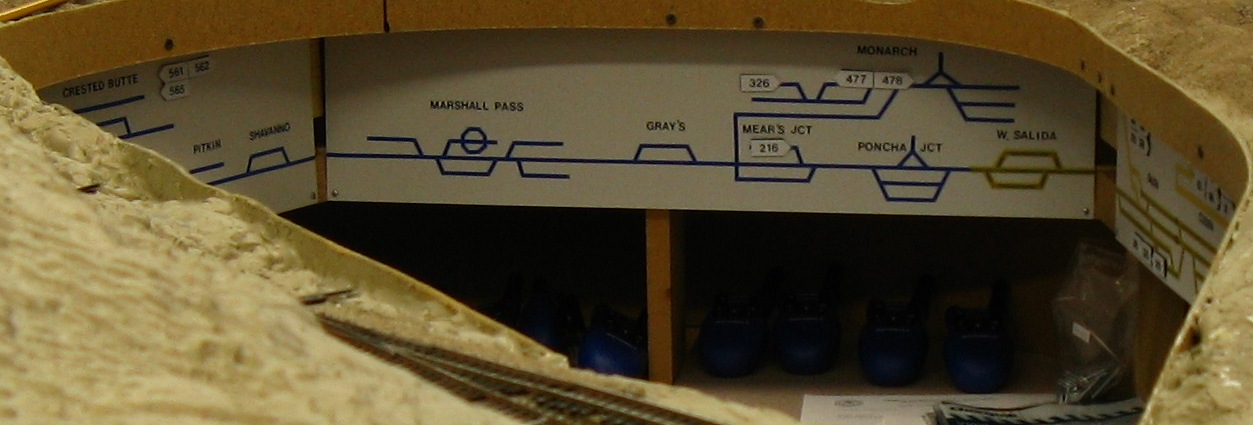
Helix
Running a set of Grant's D&RGW Heavyweights proved too much for the helix, which caused the wheels to poop out at two
locations. Track nails were pulled, track realigned to smoother radii, and reattached with caulk.


Royal Gorge Route Makeover
Additional ground has been added by Hal in the riverbed under the Howard Truss Bridge to change the river course. At
Parkdale, a sandbar is being added by Andrew to cover some water bubbles and moderate the river width.
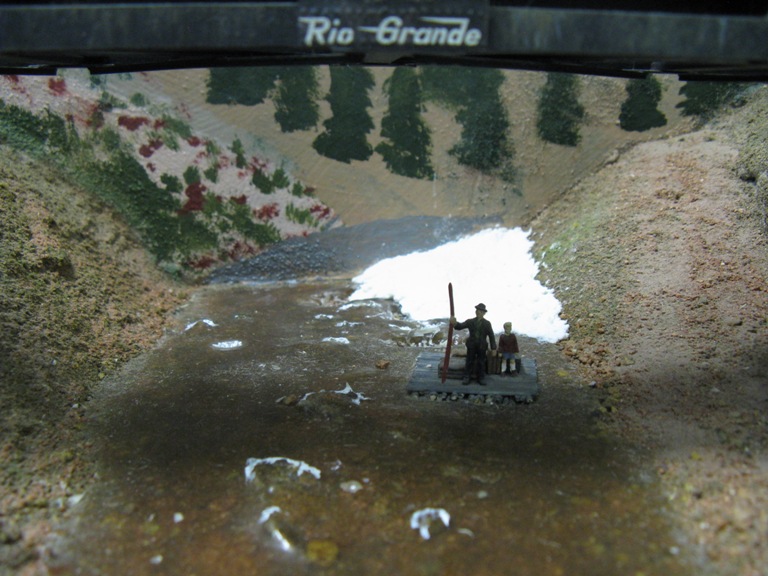



Backdrop makeover by Gary continues as time permits. Still a work in progress, check the evolution. A photo from
2007 is shown of the previous backdrop behind the bridge, and an actual photo of the scene.




Red Cliff
Barry has completed installation of switch motors to the 3 turnouts at Red Cliff and mounted toggle switches to a panel.

Monarch Branch
Grant has been laying in ground foam like mad along the switchback, with an assist by Gary. Hal has been adding
sculptamold to fill cracks and bumps. The old foam set up very fast, even with heating. The new foam has a much slower
setting time with the warm temperatures, and is acting more like expected, easing installation and making foam sheets.


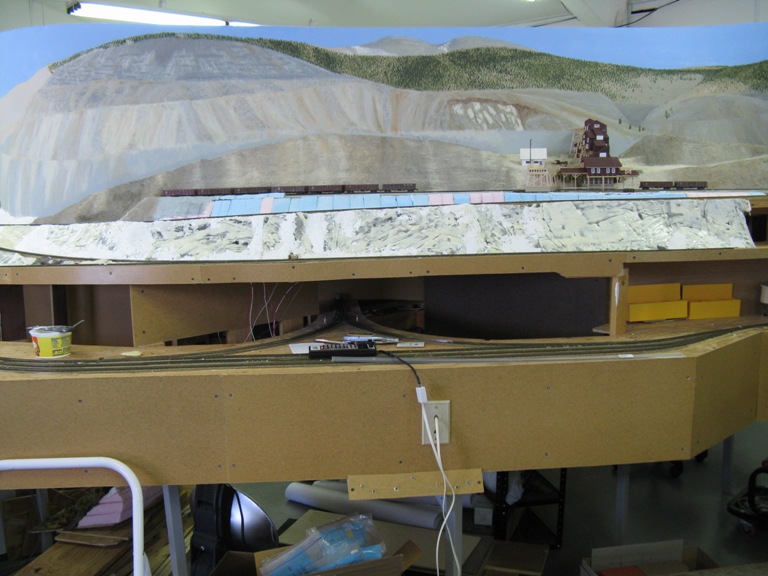
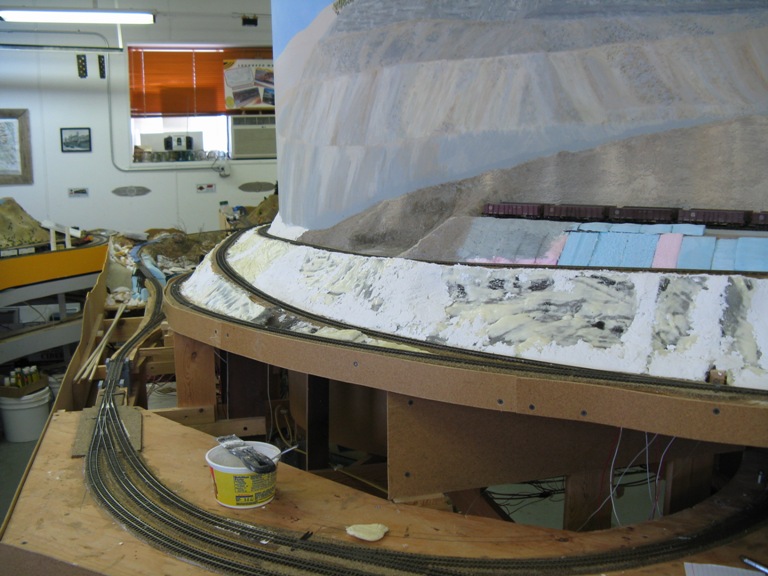
Crested Butte Branch
Barry has been making progress on the Big Mine drop shelf, for the gondola feed track for the mine.
Gray's
Jacob and Gary started working on the backdrop between Gray's and Mears, of Mt Antero, Shavanno, and Princeton from the
southeast. Gary's continued adding to the range, putting in the valley below the range.
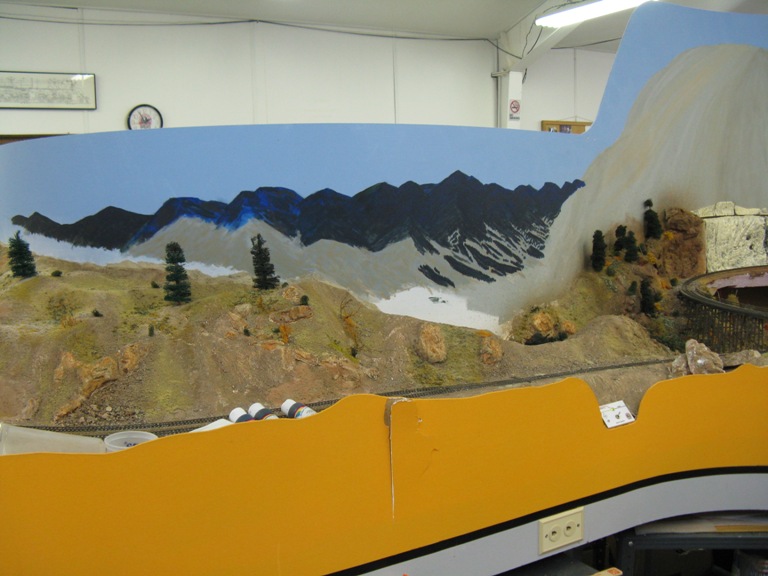

Shavanno
Gerry's been busy working on the backdrop between Tank 7 and Shavonno. Here is how the backdrop here is developing.


Colorado & Southern Quartz Creek Branch
Progress continues for the Quartz Creek "staging" branch. Gary has spiked the turnout in place and is awaiting power
connections. Since the photo was shot, the remaining rails were spiked in between the gap to the mainline, and the flex
track was caulked down on the old roadbed. Ties were removed from the micro-engineering flextrack where the gauge was
tight (Manufacturer's defect). Wood ties were placed in these gaps and at the ends of pieces to 'mate' separate flex
pieces. The remaining piece at the far end was troublesome as it was too short a piece to bend to shape and not pop out of
the spikes. After 3 pieces of microengineering failed, shinohara was attempted but also was difficult for a short length,
so ties were put in place to await rails for spiking.
The wood ties were stained with different shades of gray acrylics. The flextrack ties will be painted with different
shades of gray enamels.

White Metal Kits
Hal's HOn3 Rail car!



Gray's Siding
The spectacular view of the mountains from Gray's is now being transferred to the backdrop. The mountain chain in view is
looking northwest toward Mt Shavanno, Mt. Anterro, and Mt. Princeton. Gary roughed in the range with a dark blue, which is
intended as a base coat and frame for more proper colors.
Colorado & Southern Quartz Creek Branch
Gunnison Drop shelf
Red Cliff
Howard
Cast White Metal Project Update
Gray's Anatomy Revealed
Colorado & Southern Quartz Branch
Roughing in Red Cliff
Mear's Junction
Off the Rails
Cast White Metal Project Update
Fatality Report
The Marshall Plan
More Gray's Anatomy
Red Cliff
NG Drop Shelf
Other Notes
The Ties That Bind
NG Staging Deck Progress
Red Cliff Expansion
Roster Additions
GRAY'S ANATOMY
CARVING CRESTED BUTTE
THE MARSHALL PLAN
NEW MEMBER
WHITE METAL CAST VEHICLE WORKSHOP
RED CLIFF
GRAY'S SIDING
MARSHALL PASS
MARSHALL PASS
GUNNISON
RED CLIFF
ROSTER UPDATES
MORE NEWS
The second layer of subroadbed was cut out. The purpose of the second layer is to provide splicing of segments for smooth
roadbed, extra robustness to prevent warping (which is inevitable for single layers), and thickness so the subroadbed can be
mounted from below and through the riser, further eliminating bumps and dips in the roadbed surface. Hal glued and clamped
together the two layers of subroadbed. Gerry installed the Luann roadbed for the switch and cork. Although not
evident in the photographs, the Quartz Branch track is lower than the foreground Tank No. 7 track.
30 June 2011 Crew: Gary, & Barry


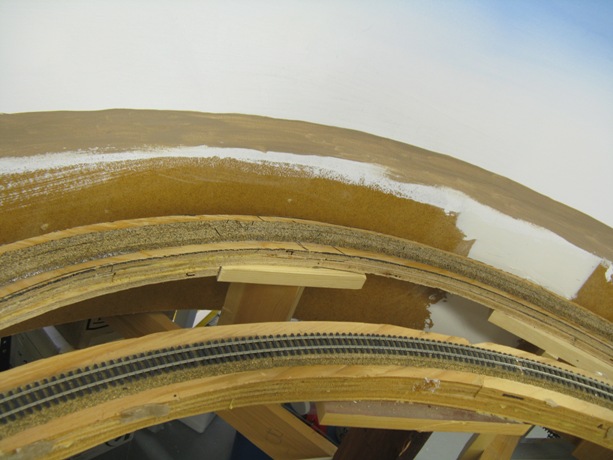
Barry made further refinements for the drop shelf for ease in handling and snugness of fit.
Gary installed the remaining feeders to the new track. Jacob and Gary removed excessive caulk that "bled" between the ties.
Barry installed a new switch control panel for the switch motors. Hal successfully completed testing of the track
(pre-switch motor hook-up) with his Challenger, and demonstrated adequate reach to the house track through the window.


The backdrop along the front of the layout is going through an improvement cycle. With more experience and new and old
photos from Red Hill Tunnel to Parkdale, Gary began applying more realistic painting. The photos below show the
previous backdrop of the truss bridge, an actual photo, and stages of the repainted area to date. Note that the tangent on
the mainline was insufficent for the extra span of the actual bridge - thus the shorter modeled bridge. Each photo shows
the progression of hills added, progressing to the foreground. Gary added Trees to the very reddish distant peak,
and Gerry demonstated painting single trees along the skyline with a fine brush. Hal added Sculptamold near the backdrop
to the riverbanks so the river can look like it is wrapping around a "bend".








Gary brought in his Wheel Works 1930s Ford dump truck. This kit was a real challenge assemblying the very soft metal parts
and poorly fitting parts, as can be seen by the roof overhang in the rear. The hood and front of the cab fit well, but the
doors, roof, and rear of the cab didn't align so well to the windshield frame. Inserting
the figure required whittling him down to fit. Windows were added by attaching with Kristal Klear to the frame. Dull Cote
and weathering was applied to complete he model. Photos always show more details that jump out in the end. The driver's
side window needs fixing (the window isn't curved at the corner and the KK left a gap along the bottom) and either the
license plate needs to be dulled with some weathering or replaced with a Micro Scale decal.


16 Apr 2011 Crew: Jacob, Gary, Barry & Hal
16 Apr 2011 Chow: Gerry, Gary, Barry & Hal
A lot of scenery work developing at Gray's, mostly due to Jacob's concerted efforts. A few ponderosa pines and some intial
scrub dot the hillside. The overall area has received its groundcover. The cut around the water tank has been filled with
more material to form the edge of the cut next to the tank, which will get paint and earth yet to come. Reddish barked
monterrey pines are set out on the blue foam. These scrub pines receive "leaves" from applications of ground foam, and
are installed one at time using tweezers and glue.
 A staging track for the Colorado & Southern line from Parlin to Pitkin is under construction.
Hal and Gerry have been building the subroadbed. The Colorado & Southern exited from South Park, to Buenva Vista, through
the Alpine Tunnel, to Pitkin, Ohio City, and entered Parlin along Quartz Creek. The Colorado & Southern obtained the track
originally from the Denver, South Park & Pacific, which was owned by theUnion Pacific under Jay Gould. The C&S tracks
left Parlin to the north of the D&RGW tracks and Tomichi Creek, and went into Gunnison. The DSP&P had a branch from
Gunnison to Baldin. The C&S was formed in 1898 out of the remains of the DSP&P and Colorado Central. In 1908, controlling
interest of the C&S was purchased by the CB&Q. After the collapse of the Alpine Tunnel in 1911, the D&RGW operated the
isolated C&S lines between Quartz and Baldwin. In Parlin, a connecting track to the D&RGW was laid. In 1934, the Quartz
branch was discontinued. In 1938, the Baldwin Branch was turned over to the D&RGW. The track to Quartz will allow for a
partially hidden train to be staged to & from Gunnison to Quartz. See the Layout Constuction
page.
A staging track for the Colorado & Southern line from Parlin to Pitkin is under construction.
Hal and Gerry have been building the subroadbed. The Colorado & Southern exited from South Park, to Buenva Vista, through
the Alpine Tunnel, to Pitkin, Ohio City, and entered Parlin along Quartz Creek. The Colorado & Southern obtained the track
originally from the Denver, South Park & Pacific, which was owned by theUnion Pacific under Jay Gould. The C&S tracks
left Parlin to the north of the D&RGW tracks and Tomichi Creek, and went into Gunnison. The DSP&P had a branch from
Gunnison to Baldin. The C&S was formed in 1898 out of the remains of the DSP&P and Colorado Central. In 1908, controlling
interest of the C&S was purchased by the CB&Q. After the collapse of the Alpine Tunnel in 1911, the D&RGW operated the
isolated C&S lines between Quartz and Baldwin. In Parlin, a connecting track to the D&RGW was laid. In 1934, the Quartz
branch was discontinued. In 1938, the Baldwin Branch was turned over to the D&RGW. The track to Quartz will allow for a
partially hidden train to be staged to & from Gunnison to Quartz. See the Layout Constuction
page.
Gerry, Hal, and Gary have worked on putting together the base and newly laid track for Red Cliff. The passing siding will
hold a freight with 12 cars. The house track is available for LCL, Express BOX, and baggage. Track feeders continue
being installed.



Scenery is creeping along at Mear's, overgrowing the voids.
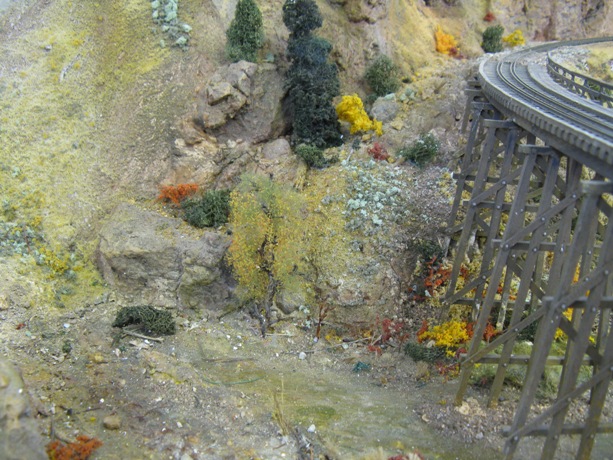
Check out the Missing Links in Off the Rails for the latest on installing a decoder in an ALCO
engine. This new and advanced technique will save you hours of frustrating time!
From our cast white metal kit clinic, Jacob brings in his completed late model Fordson tractor. This tractor will be
assigned duty at the Cleora Bar JL ranch.


Mr Elmo Bevington, former Salida resident, was found dead last week after a severe accident in which his hip and thigh
were severely crushed in mechanical apparatus. Mr Bervington's accidental
death is recorded here. Unfortunatley for Mr. Bevington, his death was a slow, drawn out and painful one.
09 Apr 2011 Crew: Jacob, & Hal
06 Apr 2011 Crew: Gary
02 Apr 2011 Crew: Hal, Barry, Gerry, Grant & Gary
30 Mar 2011 Crew: Jacob & Gary
26 Mar 2011 Crew: Hal & Gary
19 Mar 2011 Crew: Barry, Grant, Hal & Gary
19 Mar 2011 Chow: Barry, Grant, Hal & Gary
16 Mar 2011 Chow: Jacob, Barry & Gary
All track feeders from the spliced rails have been installed to new terminal strips, and wiring from switch motors inside
the "loop" rerouted around the benchwork out of the access "hole" to the Dispatcher panels.
Some rock castings have been removed from Gray's and replaced with a "dirt" cut along the face of the hill. Ground foam for
grasses have been added which look fantastic (unfortunately not shown here).

The tracks have been all installed, including an abandoned siding along the old reverse loop right of way before it was
moved to accomodate the access 'hole' to Crested Butte. There is some cleanup of some overzealous application of caulk
along the part of the mainline to be accomplished. Wiring track feeders to new terminal strips has commenced.
Self-aligning pins have been added to the drop shelf, and the final deck added, to level the drop shelf with the surfaces
at Gunnison and Cimarron. See the Layout Constuction page.
12 Mar 2011 Crew: Gerry, Jacob, Hal & Gary
09 Mar 2011 Crew: Barry & Gary
05 Mar 2011 Crew: Jacob, Andrew & Gary
26 Feb 2011 Crew: Jacob, Hal & Gary
23 Feb 2011 Crew: Jacob, Andrew & Gary
A lot of tie painting has been going on. NG ties have been completed from just uphill from the Gray's Water Tank to just
past the large trestle at Mear's Junction. Many more ties stretching back to the Dispatcher area, the Mear's siding, and
along the mainline from the Mear's trestle to where the track crosses Poncha Creek have been painted various shades of gray.
Next for those are brown & black dry brushing, and spike painting to complete those. Surely, there are millions more ties
to paint but a good portion has been completed, which will now permit final ballasting and scenicking. The ties at Poncha
Jct will be painted dark brown to simulate creosote, and will be ballasted with cinders. The line to and in W. Salida will
be modeled as all creosoted ties. The line going up to Monarch will be all painted in gray shades.
Work on the drop shelf from Cimarron to Gunnison continued, with some ingenious snap-in mounting plates to lock the shelf
in the "up" position, which will make raising or lowering the drop shelf in one easy "snap".
Platforms for the passing siding and house track & Depot have been installed. Next up: Add in 3 switches, siding and house
track. The siding should hold about a 12 car freight (40 footers).
Jacob has been growing his rolling stock collection, including three SG D&RGW stock cars and a NG caboose. GaryM added
Athearn LCL 40' Express Box Cars T&P #1703 & 1717, and RI #20003 & #20016 to his fleet. Hal recently purchased the Rapido
D&RGW Steam Generator Car. Note: If you intend to have rolling stock available for operating
sessions, please check the rolling stock roster to send me (your webslinger) the appropriate data so that the roster can be
can be updated. The roster is used as the database to put together operating sessions for different years. Thus, car
number, car type, car date information, herald style, are needed. Also remember that rolling stock used in operating
sessions will be available to all operators.
12 Feb 2011 Crew: Grant, Gerry, Jacob, Andrew & Gary
09 Feb 2011 Crew: Gary
05 Feb 2011 Crew: Hal, Gerry, Jacob, & Gary
03 Feb 2011 Crew: Gary, Jacob & Gerry
The scenery work at Gray's siding is slowly changing the topography. Rock castings are being added to jut from cut faces,
fill depressions, and add detail. Ground cover is being put in as well, transforming the area. Poncha Creek,
which flows through Mear's Junction, originates from the backdrop behind a ridge which starts the Gray's Siding scene.
Work has begun along the creek bed and ridge to "merge" the two scenes. Very soon we will be working on the backdrop to
blend into the ground work.


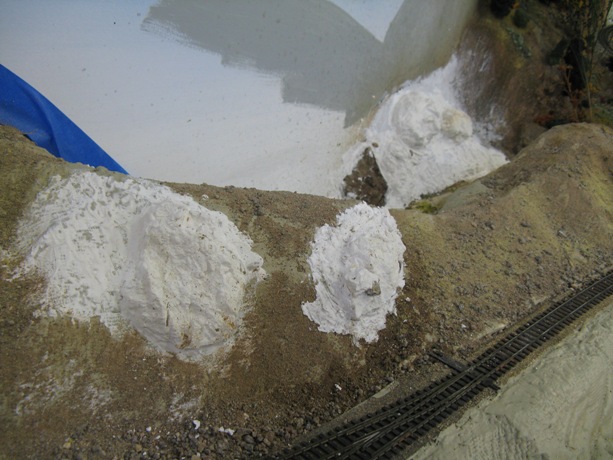
The narrow gauge flex track is being transformed as well. The uniform, dark brown ties with unpainted rails, of the flex
track is being turned into a model of track. Step 1, the unpainted rail is painted a greenish-mud colored rail brown with
a Floquil paint pen. Step 2, the ties are painted a gray enamel, painted in blocks of different color grays. Sometimes,
the plastic ties have small sprue tabs protruding from the end of the tie which is removed by an exacto-blade. Step 3, the
ties are dry brushed with a dark brown, then drybrushed with a black. Step 4, the spike heads are touched off with the
Floquil "Rust" paint pen, transforming the plastic flex track into a unique model of track. Dirt from the "cut" will be
used as "ballast", partially filling in between the ties and covering the cork.




The uneven backdrop behind the Crested Butte site was cut out to allow for scenicing. The ends now need some filler and
blending to the remaining backdrop. The challenge of blending the overhang into the backdrop is yet to come.

Track feeder work continues as another terminal strip was installed to the main track bus. Terminal strips are added for
new feeders as required.
29 Jan 2011 Crew: Hal & Gary
26 Jan 2011 Crew: Gary & Grant
22 Jan 2011 Crew: Gary, Hal, Barry, Jacob, Gerry & Grant
19 Jan 2011 Crew: Gary
15 Jan 2011 Crew: Gary, Hal, Barry, & Jacob
15 Jan 2011 Chow: Gary, Hal, Barry, Jacob, & Grant
12 Jan 2011 Crew: Gary, Barry, Jacob, & Grant
Welcome to fellow D&RGW modeler Gerry Glancy as our newest member!
For the past couple of weeks, we've worked at the Hunting & Fishing Club, concentrating on making some white metal
vehicle kits. Progress is slow but steady. We may want to designate a "Modeling Day" for working projects like these, which
can take quite some time to complete. Next week we'll go back to working on the layout.


Permanent installation of cutouts set between track and fascia underway. Passing track for 12 car train and house track
planned for Red Cliff depot.


Some scenery work around Gray's Tank area. Ties are now being painted prior to ballasting.


Track feeders have been installed on the new rails and cut rails from the stretch from Gray's winding to the back of the
inside loop. The feeders were "harnessed" to a new terminal strip tied into the bus. New track feeders are being
installed in this manner, to "clean-up" wiring, reduce bus connections, while relocating connections to centralized,
accessible locations.
8 Jan 2010 Crew: Hal Gary, Barry & Grant
5 Jan 2010 Crew: Gary & Barry
Three areas of significant track kink occurred. Unfortunately, only one photo of the least kink was taken. These occurred
over the summer due to the interior heat in the clubhouse. A progression of repairs are shown for each area. The track
actually buckled at the joint where the kink occurred. All kinks occurred at solder/rail joiner joints.












Drop shelf construction underway. See "Construction Photos"
A cardboard template of the current tracks and benchwork under Crested Butte along the "portals" was laid out full-scale.
We looked at several scenarios for what could fit in the area, what could be reached, what could be operated, and what
could be "modeled". We decided to model a depot at Red Cliff, with a house track and a passing siding.




Intermountain D&RGW 2-Bay 70 Ton Covered Hoppers (Blt 1946) 18355, 18358, 18361, 18362. Rivarossi wedge plow repainted
for D&RGW X-066. Athearn American Refrigerator Transit 40' Reefers 31207, 31213, 31221, 31234, 31247 & 31265.
![]()

![]()
![]()
2010 Status Reports
2009 Status Reports
2008 Status Reports
2007 Status Reports